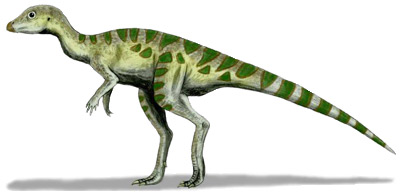
|
Search JoyZine with Google Site Search! |
Leaellynasaura
AGE: Early Cretaceous (Albian) 106 MYA REFERENCE: Otway Group Referred specimens: Strzelecki Group Leaellynasaura was a fast-running, plant-eating dinosaur that lived in Australia during the middle Cretaceous Period, roughly 115-110 million years ago. Leaellynasaura was named in 1989 after Leaellyn, the daughter of Thomas A Rich and Patricia Vickers-Rich, the discoverers and namers of the dinosaur; saura is the feminine form of lizard in Greek. It is one of many dinosaurs whose partial remains have been dug (and blasted) out of the solid sand- silt- and mud-stones of Dinosaur Cove, Victoria. The holotype is of a juvenile about 75cm long and 30cm high, although adults probably reached almost 1 metre in length. Its body shape and lifestyle are based on that of its close relatives, the hypsilophodonts (dinosaurs with high-ridged teeth). This was a very successful group of dinosaurs which lived in most parts of the world. Leaellynasaura was a small, turkey-sized herbivorous biped, but differed from other hypsilophodontids in its upper hind leg bone structure (at its base it gets wider from back to front). It had a relatively large brain, a cheek pouch with self-sharpening cheek teeth, a tough beak, strong jaws and good eyesight. Hypsilophodontids probably fed on ferns, cycads and horsetails that grew in the understorey of the forest. Perhaps they also scrambled into the trees, in much the same way as goats do, but they weren't really built for climbing. The polar forest that Leaellynasaura lived in included conifers (like araucarias and podocarps), and ginkgo trees. Flowering plants would have been extremely rare, and probably restricted to small ground plants, which hypsilophodonts may also have eaten. An enlarged optic lobe in an excellantly preserved endocast of the brain may indicate that Leaellynasaura was well adapted to living for extended periods in the winter darkness. The fact that dinosaur remains are here at all, and also to be found in the Arctic, suggests that their metabolism was probably not cold-blooded, like modern reptiles. Remains of an Antarctic hypsilophodont were found that might be closely related to Leaellynasaura. Associated with this material in the frozen south were shells, tree trunks, ferns, and tree leaves. |
